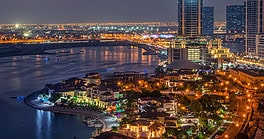With Saudi Arabia’s non-oil sector reaching 50% of GDP for the first time last year, the Gulf nation marked a watershed in its diversification from fossil fuel dependency.
Government data released last month shows the real GDP growth rate for non-oil activities at about 4.4%, valuing the sector at about 1.7 trillion Saudi riyals (around $453 billion). This puts the kingdom on course to meet the objectives set out in Vision 2030, its broad program of policies and reforms, which holds economic diversification as one of its core objectives.
“The oil and gas sector is highly capital intensive and does not create the flow of job opportunities required to meet the supply of labor from a young and increasingly educated population,” says Nasser Saidi, an economist and Lebanon’s former minister of economy and trade, noting that around 30% of Saudi Arabia’s population is below age 30.
To meet the challenge, the government has introduced incentives aimed at growing both services and manufacturing. As a result, much of the non-oil sector’s growth last year was driven by private consumption in areas like entertainment, hospitality and tourism. Together, they accounted for 40% of economic activity last year.
The tourism sector, which has attracted $13 billion in private investments recently, has been a particularly strong point, Saidi notes, luring 27 million foreign visitors last year in addition to 77 million domestic travelers.
These achievements did not stop the kingdom from suffering a 4.3% year-on-year decline in real GDP in 2023, however. The principal culprit was a drop in oil sector activity caused by voluntary production cuts put in place by the OPEC countries amid market concerns and rising output outside the group. Moreover, the majority of Saudi wealth is still to be found below ground, even when oil production is not considered. Mining and quarrying accounted for one-third of total non-oil output last year. Outside of these sectors, manufacturing accounted for more than 15% of real GDP, while real estate and construction contributed 14%.




